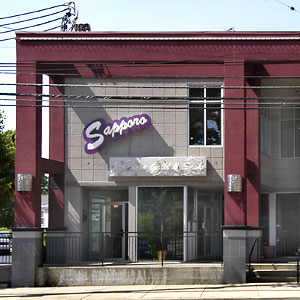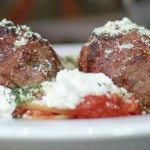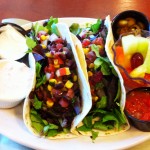LEO’s Eat ‘n’ Blog with Louisville HotBytes: Raw, Sapporo, Maido
 |
| Illustration by Gina Moeller |
Like so many great culinary masterpieces, sushi traces its origin to the most prosaic of sources, according to sushi expert Dave Lowry, author of the useful pocket-size handbook, “The Connoisseur’s Guide to Sushi.”
“Legend credits the invention of sushi to an old woman who was worried that bandits might steal a pot of her rice,” Lowry writes. “She shinnied up a tree and stashed the rice in an osprey nest until the threat passed. When she retrieved the rice, it had begun to ferment. She also discovered that some of the ospreys’ fish scraps, which had fallen into the rice, were not only edible, but also, as far as comestibles left exposed to the elements in the living quarters of messy birds of prey go, rather tasty.”
Well, isn’t that appetizing?
This hypothesis would come as no surprise to folks in this inland town, though, where until just a few short years ago most of us thought of sushi as, well, bait. Louisville’s first sushi came to town as recently as the early 1980s, and so tentatively that, as I recall, it started as a Thursday lunch-only special at a Fourth Street diner that on other weekdays specialized in things like meatloaf and chicken-fried steak.
The pioneering itamae (skilled sushi-maker) went on to open Sachicoma on Baxter, the city’s first real sushi bar, around 1985, but it would take another 15 years or so – and, perhaps, the arrival in Kentucky of a giant Toyota plant and a squadron of Japanese subcontractors – before an increasingly diverse and arguably more sophisticated community reached the happy point where we can support a dozen sushi bars or more. Now even grocery stores offer a version of the stuff, available for carry-out in white Styrofoam boxes, and surely McSushi is not far beyond the horizon.
So, now that Louisville foodies have learned to greet the itamae with a cheery “konnichi-wa” (“good afternoon”) and a crisp “Hai!” (“Yes”) when he forks over a bite, we’ve become certified sushi-tsu (“experts,” or perhaps “snobs”). No longer awed by the mere idea of eating raw fish – and liking it – we’ve become discerning. We want our sushi to be fresh, and right, even if we do live 700 miles from the nearest body of salt water.
Sachicoma is gone now, perhaps unable to keep up with the city’s maturing tastes in exotic raw seafood; but the city boasts a wealth of fine sushi-ya (restaurants). Let’s take a look at Louisville’s newest sushi emporium – the glitzy new Raw Sushi Lounge – and see how it stacks up against two of the city’s best.
 |
| Photo by Robin Garr: The Raw Sushi Lounge makes sushi hip, with its modern decor and lounge-like relaxed environment. |
Raw Sushi Lounge
520 S. Fourth St.
585-5880
Score: 76 points
Call them urban pioneers with a sharp eye for a risk with high payoff potential: Partners David Grace, who was once the general manager of Jillian’s, and Anthony Noland took advantage of a $50,000 “forgivable loan” from a city economic-development pool as part of the financial base for this venture on the ground floor of the historic Marmaduke Building. Just one door south of the Seelbach Hotel, it’s poised to skim some of the cream from the crowds seeking downtown fun in nearby Fourth Street Live. At the same time, it’s one of the most significant recent ventures into a grim stretch of wig shops and vacant storefronts between the Seelbach and the Palace Theater that has resisted gentrification for years.
Raw offers gentrification in living color. Its expansive 4,100-square-foot space is slick yet spartan, lofty and appropriately dim, with a serpentine bar that culminates in a pulpit-like half-circle where itamae Mia Choi (formerly of Bendoya Sushi Bar) and her son, Troy, shape sushi creations while standing high above the throng. (There’s no seating at this sushi bar – if they’d let you do it, you’d have to stand up, stretching up on tiptoe for a bite.)
Spartan, carpenter-zen decor features free-form stacks of unfinished wood and, along one wall, broad vertical planks that curl away from the wall at the top with a casually chic look that unfortunately resembles a basement family-room project gone badly awry. Tables seem hand-hewn, too, heavy blonde-wood-look squares that, on closer inspection, appear to be made of heavy plywood topped with chipped veneer. Lightweight brown plastic-and-metal side chairs are stackable but stylish, with the look of a set picked up on a closeout sale at Ikea.
In keeping with the lounge theme, a small front section and much of the back portion of the auditorium-size room are furnished not with dining tables but large, square gray couches and low coffee tables, providing a comfortable setting for relaxing and enjoying drinks and music, if a difficult reach for dining with chopsticks.
We’ve found the food good but short of compelling on several visits, with service ranging from courteous to enthusiastic and from competent to amiably addled. The bill of fare is heavy on seafood with a strong sushi component, as you would expect, but enhanced (on the dinner menu only) with a selection of intriguing if rather pricey main courses that go beyond seafood and range around the world. Sushi includes standard nigiri-zushi (seafood bites atop balls of rice) and maki-zushi (sushi “rolls” cut in bite-size, rice-wrapped rounds) from $4 (for various nigiri-sushi, served in pairs) to $15 (for “fire roll” with shrimp tempura, avocado and cucumber within). Raw specials and sushi platters – with a slightly wider selection evenings – can range upward to $64 for a 20-piece sashimi-and-sushi platter for the table.
The half-dozen non-sushi dinner entrees range in price from $16 (for a spicy teriyaki chicken dish with stir-fried vegetables) to $29 (for an Asian filet, grilled beef tenderloin served on sautéed shiitake mushrooms, bok choy cabbage and green onions). A grilled rack of lamb with a cilantro-orange-hoisin glaze is $28, and scampi-style shrimp with a sho chiku bai sake marinade is $21.
We’ve tried a good selection of the sushi and found it workmanlike if not quite up to black-belt itamae level: Tuna ($5), albacore ($5), yellowtail ($6), red snapper ($4) and mackerel ($4) nigiri-zushi have been consistently fresh but carelessly constructed, with oversize bites of fish casually draped over undersize rice balls, loosely wrapped and likely to fall apart just as you dip them into your dish of soy sauce. (Sushi-tsu tip: Always touch the fish side to the soy, never the rice side.)
Fancier sushi rolls, showing off the itamae’s creativity, look appetizing and are made well, although flavors have tended toward the delicate side. Yum Yum roll ($7) stuffed with crab meat and salmon roe, gains authority from a bright, spicy splash of sriracha hot sauce across the tops. White Tiger roll ($10) places a raw jalapeño pepper stuffed with cream cheese at the center of a maki roll for a multicultural experience indeed. Cherry Blossom roll ($12) is a pretty construction of rice around silken raw red snapper, meaty albacore tuna and crisp cucumber in a white roll decorated with a thin slice of red tuna.
We were mighty pleased with a main-dish entrée of ginger pesto-crusted snapper ($22), an admirable piece of perfectly fresh fish with a thin coating of pesto with a lemony-tart touch of fresh ginger, plated on a rich, not-too-sweat coconut cream sauce, served not on the traditional rice but a bed of toothsome couscous, a triumph of ethnic “fusion.”
Vegetable spring rolls ($7), not your crunchy fried wonton roll but the Vietnamese-style cool roll wrapped in rice paper, were competently made, but seemed empty without the customary shrimp; and pot-stickers ($7) – actually crispy fried dumplings – filled the bill as a salty pre-meal appetite-awakener. We’ve also enjoyed Japanese miso soup ($3.50), a dish that is not on the menu but is sometimes available on request.
Sushi is not a budget adventure. We’ve spent upwards of $40 for each of two lunches at Raw (without alcoholic beverage), and close to $80 plus tip for dinner (with a couple of Japanese beers). The dinner was filling enough, but one of our lunches – limited to a few nigiri-zushi and a shared set of maki – left us so short of comfortably full that we made a spur-of-the-moment stop at Shiraz Mediterranean Grill and had a falafel and kebab for dessert.
 |
| Photo by Robin Garr: Sapporo, now a Highlands staple, offers the classic, face-to-face sitting experience with the sushi bar. |
Sapporo Japanese Grill & Sushi
1706 Bardstown Road
479-5550
Score: 89 points
After several Raw experiences, I felt a need to compare the sushi against my previous favorite. Five years old and already a Highlands institution, Sapporo is glitzy and hard-edged, too, with a bit more of a high-tech industrial vibe that looks a bit higher-budget. More important, from the sushi-tsu perspective, it offers a classic, traditional sushi bar. Sitting face-to-face with the itamae, checking out the selection of fish together and watching as he fashions your dinner to order is a big part of the sushi experience to me, and it’s lacking at Raw.
More to the point, Sapporo’s sushi isn’t merely credible, it’s excellent, competitive in quality and style with sushi I’ve enjoyed in New York City … and in Tokyo. We scarfed our way through an indulgent selection of sushi, ranging from simple but perfectly formed saba (mackerel, $3.75) and white tuna ($4) nigiri and asparagus-filled maki ($3.50), plus intensely flavored salmon-skin roll ($4.50) and crisp, crunchy tempura roll ($7.50). I couldn’t resist going for a special, White Castle roll ($6.95), eagerly anticipating a set of tiny “sliders” artfully presented on sushi rice, but noooo … the name apparently refers to a samurai palace, an all-white roll featuring white tuna, cucumber and cream cheese wrapped in snowy rice. It would still be great at 4 a.m. after a night at a party.
Eight nigiri and maki plus miso soup and green tea left us comfortably full, and we got away for an entirely reasonable $43.41 plus tip.
Roll reversal: A sushi newbie becomes a fan at Maido
Another relatively recent arrival on the sushi scene that’s become one of my go-to places is Maido, a funky but lovable spot in Clifton that produces not only estimable sushi but a delicious array of Yokahama sarariman-style small plates, boasts Louisville’s leading sake bar and a fine beer selection. Eat’N’Blog correspondent PAIGE MOORE went forth to check it out, and she took along a sushi-wary friend who soon became a convert.
 |
| Photo by Robin Garr: Maido has the chops to make even the most sushi-wary person a true fan. And it’s quite colorful, too. |
Maido Essential Japanese
1758 Frankfort Ave.
894-8775
Score: 88 points
We’ve all got that friend who votes “no” whenever anyone says, “Hey, let’s go for sushi!” The one who doesn’t like fish or seaweed or, well, raw stuff. So imagine my surprise when my friend Susan announced she was ready to try sushi for the first time.
We chose Maido because it offers plenty of Japanese pub-style fare, so Susan would have some non-raw options. Maido’s beef kushikatsu, for instance, is the best steak-on-a-stick outside the state fair. Our newbie also liked Maido’s detailed and explanatory menu, which is much less intimidating than the usual sushi-bar checklist with miniature-golf-sized pencil.
Sushi’s artful look excited our newbie, who exclaimed, “It’s all so colorful and pretty!” Like an old pro, she poured soy sauce into her dipping bowl and mixed in a dollop of wasabi (a spicy paste that looks like guacamole and tastes like horseradish). We explained that the pink stuff is sliced ginger, which adds a cool counterpoint to the wasabi’s heat. As for the chopsticks, we advised Susan to just ignore ’em. There’s no shame in eating with your fingers – and Maido’s friendly servers don’t look at you funny if you ask for a fork.
First up were the cooked rolls. Our newbie liked the spicy crab roll, but admitted the seaweed wrap would take some getting used to. The “Migrating Highlander,” a fried roll with salmon and avocado, suited her a little better: It didn’t taste like fish, and the frying took some bite out of the seaweed.
On to the uncooked selections: Susan took a bite of salmon roll and said, “Yep, it tastes like salmon.” Uh, oh. That didn’t bode well for our next roll. But after one bite of the “Romantic Journey” – uncooked scallops with red and yellow peppers – her face lit up as she declared it “yummy.” She liked the mild, not very fishy flavor of the scallops, and the delicate soy wrapper pleased her more than black nori seaweed. Success!
No, we didn’t convert our sushi newbie to a sushi addict. But from now on, we’ll have one less “no” vote for girls’ night out at a sushi place – especially if it’s Maido.
BECOME A SUSHI-TSU!
Dave Lowry’s “The Connoisseur’s Guide to Sushi” is available from Amazon.com in hardcover for just $10.78, a 23 percent discount off list price. Purchases made using this exact link will return a small commission to LouisvilleHotBytes.



